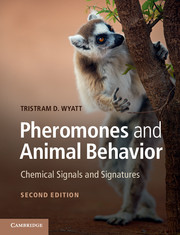Book contents
- Frontmatter
- Dedication
- Contents
- Preface to the second edition
- Acknowledgments
- List of SI prefixes
- List of Abbreviations
- 1 Animals in a chemical world
- 2 Methods for identifying and studying semiochemicals
- 3 Pheromones, chemical cues, and sexual selection
- 4 Coming together and keeping apart: aggregation pheromones and host-marking pheromones
- 5 Territorial behavior and semiochemicals
- 6 Semiochemicals and social organization
- 7 Pheromones and recruitment communication
- 8 Fight or flight: alarm pheromones and cues
- 9 Perception and response to chemical communication: from chemosensory receptors to brains, behavior, and development
- 10 Finding the source: pheromones and orientation behavior
- 11 Breaking the code: illicit signalers and receivers of semiochemicals
- 12 Using semiochemicals: applications of pheromones
- 13 On the scent of human attraction: human pheromones?
- Appendix An introduction to chemical terms for non-chemists
- References
- List of Credits
- Index
9 - Perception and response to chemical communication: from chemosensory receptors to brains, behavior, and development
Published online by Cambridge University Press: 05 June 2014
- Frontmatter
- Dedication
- Contents
- Preface to the second edition
- Acknowledgments
- List of SI prefixes
- List of Abbreviations
- 1 Animals in a chemical world
- 2 Methods for identifying and studying semiochemicals
- 3 Pheromones, chemical cues, and sexual selection
- 4 Coming together and keeping apart: aggregation pheromones and host-marking pheromones
- 5 Territorial behavior and semiochemicals
- 6 Semiochemicals and social organization
- 7 Pheromones and recruitment communication
- 8 Fight or flight: alarm pheromones and cues
- 9 Perception and response to chemical communication: from chemosensory receptors to brains, behavior, and development
- 10 Finding the source: pheromones and orientation behavior
- 11 Breaking the code: illicit signalers and receivers of semiochemicals
- 12 Using semiochemicals: applications of pheromones
- 13 On the scent of human attraction: human pheromones?
- Appendix An introduction to chemical terms for non-chemists
- References
- List of Credits
- Index
Summary
All animals detect and react to molecules in the external environment, including pheromones, signature mixtures of other individuals, and the chemical cues that indicate food, shelter, pathogens or predators. Despite the great external diversity in appearance of antennae and noses, animals of all kinds perceive these chemical stimuli in the same way (Hildebrand & Shepherd 1997; Su et al. 2009; Touhara & Vosshall 2009). Chemosensory receptor proteins are exposed to the outside world in the membrane of chemosensory nerve cells, often through a “window” in an otherwise impermeable skin or cuticle (Figure 9.1). The arrival of an odor molecule (odorant) is converted into a signal to the brain by first binding to a chemosensory receptor protein. Odorants can be any kind of molecule, as large as a protein or as small as formic acid.
Whether in air or water, olfaction is the key sense used to detect most chemical cues, rather than taste (gustation) (see Box 9.1 for the differences between these senses). All signature mixtures (the molecules learned highly varied individual or colony odors; Chapters 1 and 6; Sections 9.8 and 9.9), and probably most pheromones, whatever the size of molecules, are detected by olfaction. However, some pheromones in invertebrates are detected by gustation, including some in Drosophila (Section 9.5.2). Some pheromones in both vertebrates and invertebrates may act directly on the brain or other organs (Sections 9.5.2 and 9.7.3.2).
- Type
- Chapter
- Information
- Pheromones and Animal BehaviorChemical Signals and Signatures, pp. 173 - 222Publisher: Cambridge University PressPrint publication year: 2014
- 1
- Cited by

